The conversation around artificial intelligence has shifted from "if" to "how." For marketing agencies, the challenge isn't just adopting AI but integrating the right tools to deliver tangible results—from enhanced client reports to more efficient creative workflows. This isn't about chasing trends; it's a strategic necessity for agencies looking to scale operations, boost profitability, and stay ahead of client expectations. The right stack of AI tools for marketing agencies can automate repetitive tasks, unlock deeper data insights, and free up your team to focus on high-value strategic work.
This guide moves beyond generic feature lists to provide a curated resource of top-tier AI platforms. We'll explore solutions across key agency functions including content creation, analytics, project management, and automation. To see how specific automation tools can drive efficiency and growth, explore the 12 Best SMS Automation Tools for business optimization.
Here, you will find a detailed breakdown of each tool, complete with screenshots, direct links, and practical use cases tailored for agency environments. We analyze specific features and offer an honest look at potential limitations to help you make an informed decision. Our goal is to help you select the platforms that will genuinely streamline your processes and deliver a measurable return on investment for your clients.
1. Scribbl: For Capturing and Actioning Client Meeting Intelligence
Scribbl stands out as a premier choice among AI tools for marketing agencies, specifically engineered to maximize the value extracted from every client interaction. It operates as a sophisticated AI meeting assistant that seamlessly integrates with Google Meet via a Chrome extension, eliminating the need for intrusive bots that can disrupt the natural flow of conversation. This tool is a powerhouse for agency teams, designed to capture, analyze, and action insights from sales calls, client check-ins, and internal strategy sessions.
For agencies, where client communication is the bedrock of success, Scribbl provides a clear competitive advantage. It automatically records and transcribes meetings, but its true power lies in its post-meeting analysis. The AI intelligently generates concise summaries, organizes discussions by topic, and, most crucially, identifies and assigns actionable items. This ensures no detail from a client call is ever lost.

Why Scribbl Excels for Marketing Agencies
Scribbl is more than just a transcription service; it’s a strategic asset for client relationship management. Account managers can quickly share meeting highlights with stakeholders, while project managers can instantly turn discussion points into tasks within platforms like Asana, Monday.com, or ClickUp. The platform’s ability to detect upsell opportunities, client sentiment, and potential scope creep provides an early warning system that is invaluable for account growth and retention.
Key Takeaway for Agencies: Scribbl transforms your client meetings from simple conversations into a searchable, actionable database. This allows for unparalleled transparency and accountability, ensuring every team member, from sales to project management, is aligned with client needs and expectations.
Practical Agency Implementation & Use Cases
- Sales & Discovery: Your sales reps can focus entirely on building rapport, confident that Scribbl is capturing every client requirement. Post-call, the AI can even help auto-generate proposals and follow-up emails, drastically reducing administrative time.
- Account Management: Monitor client sentiment across all meetings to proactively address concerns. Easily reference past conversations to ensure continuity and demonstrate you’re listening to their strategic needs.
- Project Management: Directly convert action items from a client kickoff call into a project plan in your agency's preferred task management tool, ensuring a seamless transition from sales to execution.
Getting started is straightforward: install the Chrome extension, connect your Google account, and Scribbl will automatically join your meetings. The free plan, which includes 15 monthly meeting credits, makes it an accessible tool for agencies of any size to test its impact.
Website: https://www.scribbl.co
2. HubSpot AI: For Integrating AI into an All-in-One CRM
For marketing agencies already invested in the HubSpot ecosystem, the platform’s native AI capabilities offer a powerful, integrated solution. Instead of juggling disparate tools, HubSpot AI embeds generative and predictive features directly into the familiar CRM interface, streamlining agency workflows from content creation to client lead management. This makes it one of the most cohesive AI tools for marketing agencies aiming for operational efficiency.
Your team can instantly generate blog post outlines, email copy, and social media updates for clients directly within the content editor. The AI also assists with creating compelling website CTAs and landing page copy, ensuring brand consistency across all client campaigns.
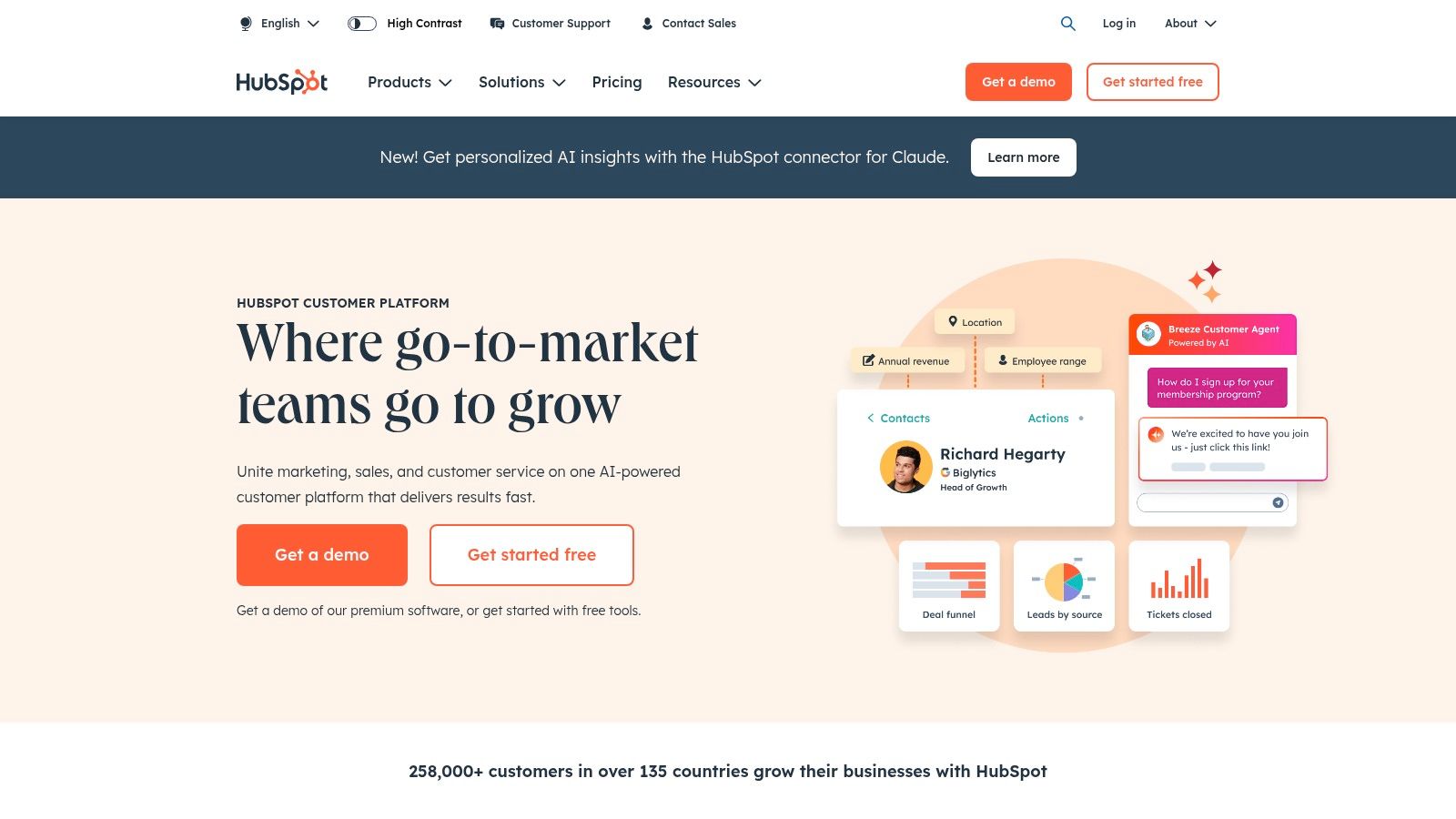
Key Agency Use Cases & Implementation
HubSpot AI excels at enhancing agency operational efficiency. The AI-powered predictive lead scoring helps your team prioritize high-value prospects for clients, while automated data cleansing maintains a healthy client CRM. For deeper strategic value, you can utilize the AI to analyze customer data and forecast trends, enabling more data-driven campaign planning for your clients.
- Pros: Seamless integration with the HubSpot platform, reducing tool fragmentation for your agency. The user-friendly interface is accessible for non-technical team members.
- Cons: The most advanced AI features are often gated behind higher-tier Marketing Hub or Sales Hub subscriptions, which can be a significant investment for a growing agency.
Many core AI features are included in Starter plans, but for full functionality, Professional or Enterprise tiers are necessary. For a more in-depth look at leveraging such platforms, explore how AI empowers marketing agencies.
Website: https://www.hubspot.com/
3. Jasper AI: For Scaling High-Quality Client Content Creation
When your agency team needs to produce high-quality marketing copy at scale for multiple clients, Jasper AI stands out as a dedicated content creation engine. It's specifically designed to accelerate writing workflows, allowing agencies to draft everything from client blog posts and social media updates to ad copy and product descriptions in minutes. This focus on versatile, rapid content generation makes it one of the most valuable AI tools for marketing agencies managing multiple client accounts.
Jasper’s extensive library of over 50 templates provides a structured starting point for virtually any marketing task. You can input client-specific brand voice guidelines and key information to ensure outputs align with each client’s unique style, saving significant editing time and maintaining consistency across all channels.
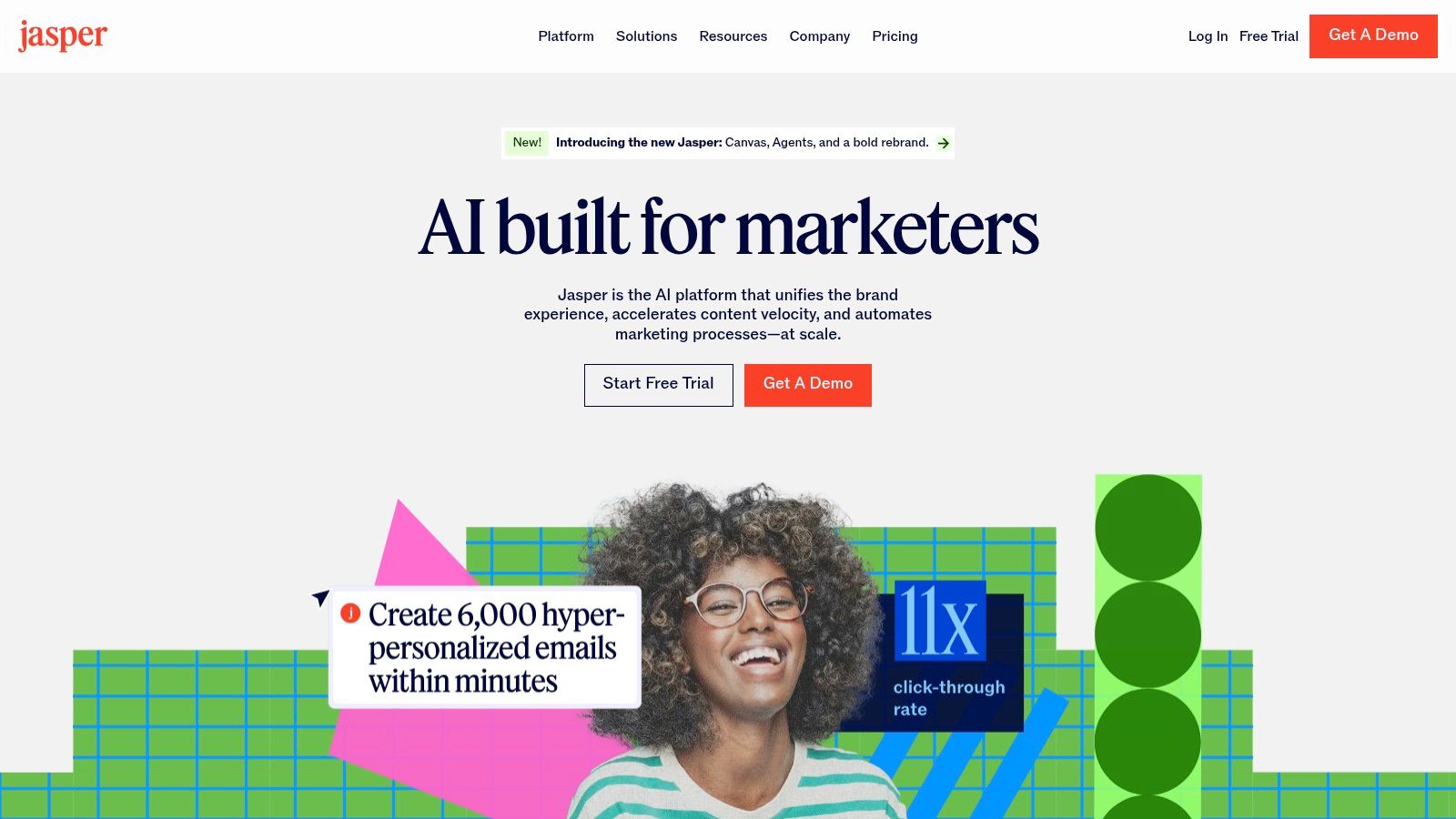
Key Agency Use Cases & Implementation
Jasper is ideal for agencies looking to supercharge their content production pipeline. Use it to quickly overcome writer's block for client blogs, generate multiple variations of ad copy for client A/B tests, or even draft entire email marketing sequences. The platform's support for multiple languages is a major asset for agencies serving international clients, allowing them to adapt campaigns for different markets efficiently. For best results, team members should still fact-check and refine the AI-generated content, especially for clients in highly technical or niche industries.
- Pros: Dramatically accelerates content creation workflows and offers extensive templates for agency tasks. Strong support for maintaining a consistent brand voice for each client.
- Cons: Outputs for highly specialized or niche client topics may require significant manual editing and fact-checking to ensure accuracy and depth.
Jasper offers several subscription tiers based on usage needs, with pricing starting at a monthly rate for individual creators and scaling up for agency teams requiring more advanced features and collaboration tools.
Website: https://www.jasper.ai/
4. Copy.ai: For Rapidly Generating Diverse Marketing Copy
When your agency needs to rapidly generate diverse marketing copy for multiple clients, Copy.ai provides a versatile and accessible solution. Its strength lies in a vast library of over 90 templates designed to tackle specific marketing tasks, from brainstorming ad headlines to drafting full-length blog posts for clients. This makes it an ideal platform for agencies needing to scale content production without sacrificing variety, positioning it as one of the most flexible AI tools for marketing agencies.
The platform supports content creation in over 25 languages, a crucial feature for agencies managing international client accounts. Its user-friendly interface ensures that even junior copywriters or account managers can quickly produce first drafts, freeing up senior strategists for higher-level work.
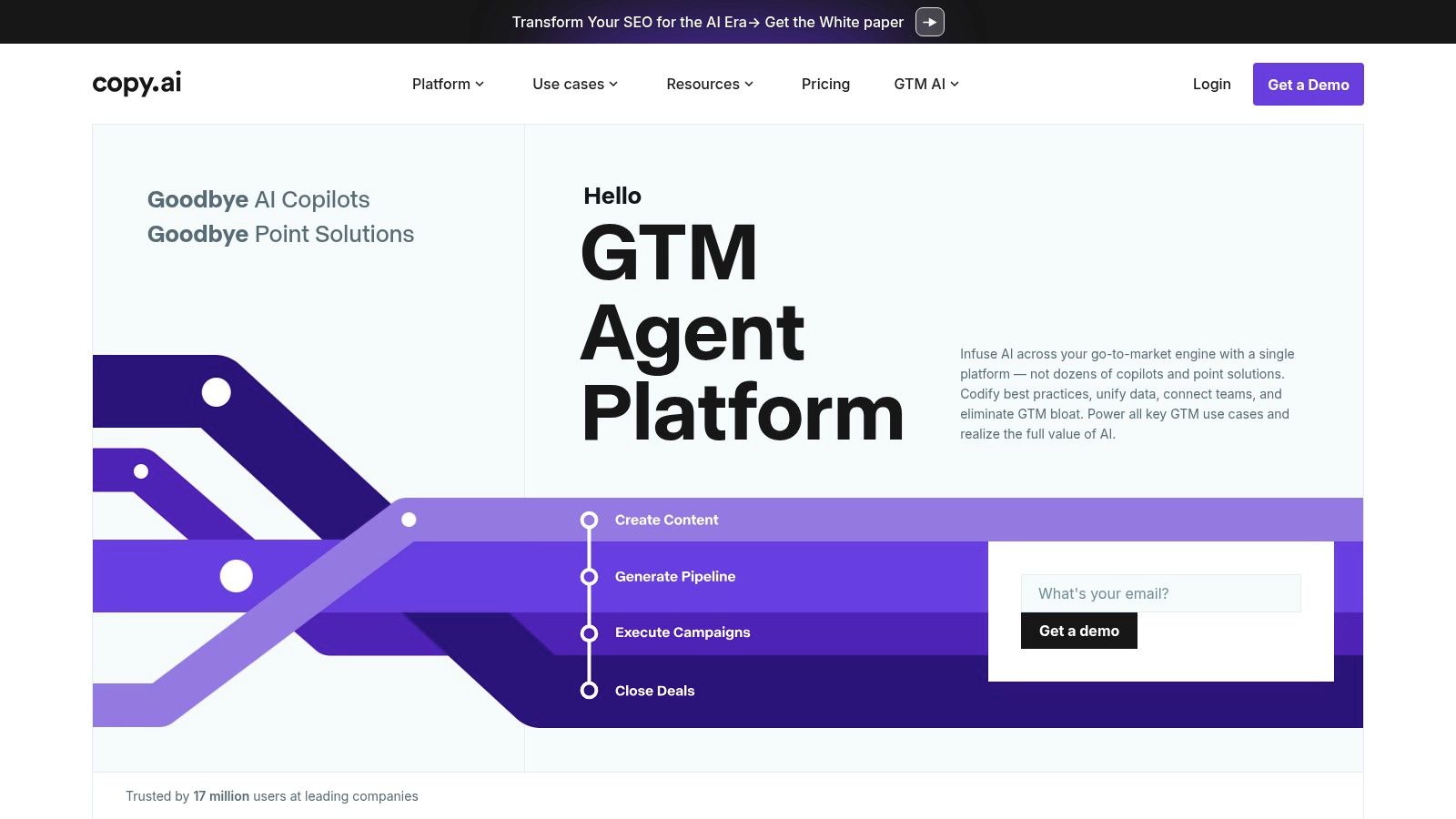
Key Agency Use Cases & Implementation
Copy.ai excels at accelerating the initial stages of the content lifecycle for clients. Agencies can use its templates to quickly generate social media calendars, product descriptions for e-commerce clients, and multiple email marketing variations for A/B testing. The "Brand Voice" feature allows you to input client-specific style guides, ensuring the AI's output aligns with their established brand personas.
- Pros: Speeds up content creation dramatically and offers a generous free plan for basic agency needs. The extensive template library covers almost any marketing copy requirement.
- Cons: The generated content often requires significant human editing and refinement to meet professional standards and avoid a generic feel for client work.
The free plan is suitable for small-scale tasks, but agencies will need a paid Pro plan to access unlimited words, multiple brand voices for clients, and the latest features.
Website: https://www.copy.ai/
5. Zapier: For Automating Agency and Client Workflows
For agencies looking to glue their tech stack together, Zapier acts as the ultimate automation conduit. It’s a no-code platform that connects over 7,000 different applications, allowing your team to create automated workflows (called "Zaps") that handle repetitive client and internal tasks. This makes it an indispensable tool for integrating various AI tools for marketing agencies into a single, cohesive system.
You can automatically send leads from a client's Facebook Ad campaign to a Google Sheet and then into their CRM. Or, trigger an AI content generator to draft a social media post whenever a new article is published on a client's blog, streamlining content distribution without manual intervention.
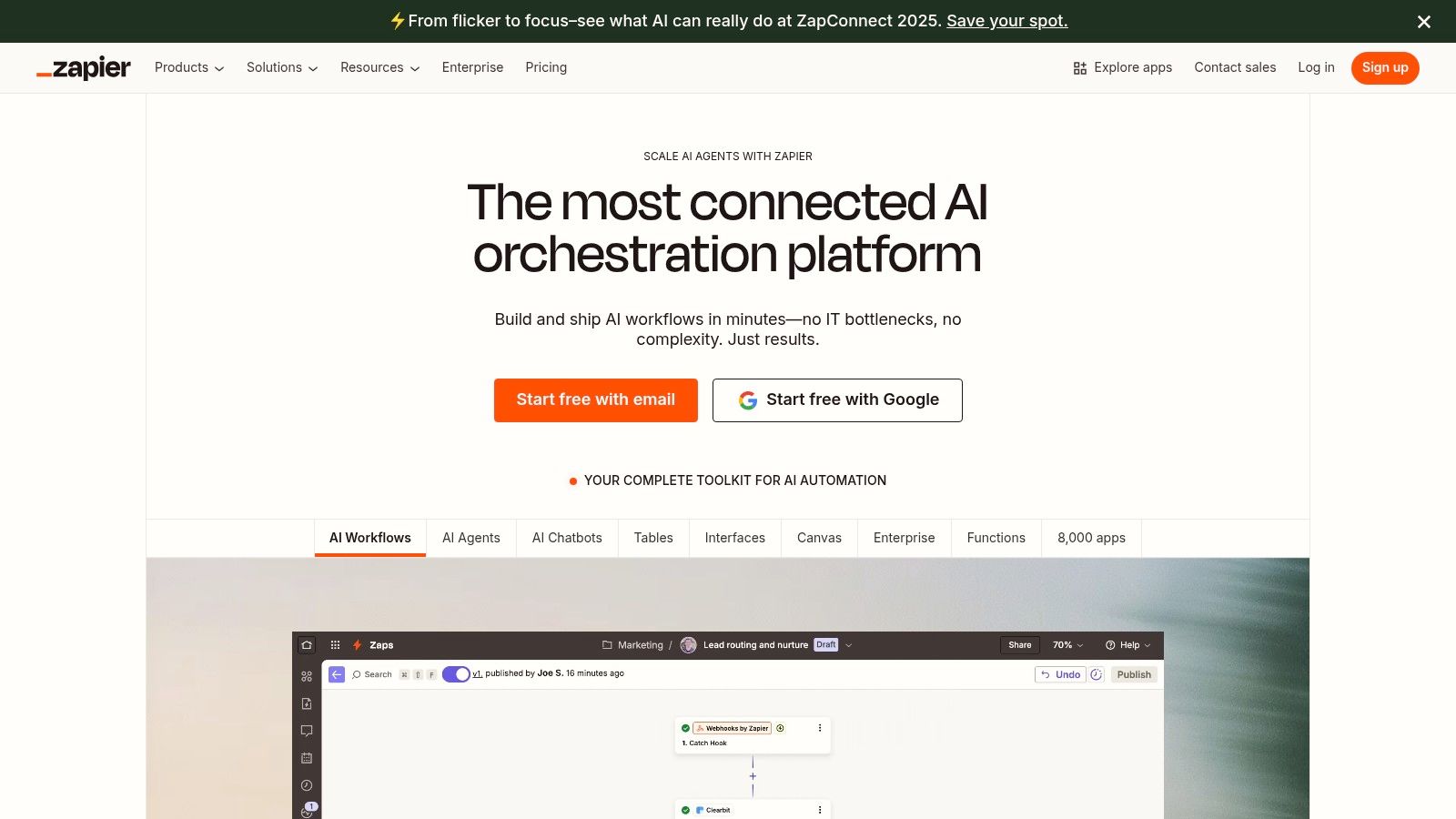
Key Agency Use Cases & Implementation
Zapier’s true power for an agency lies in its ability to connect disparate systems and embed AI actions within existing processes. An agency can create Zaps that automatically analyze new customer support tickets with a sentiment analysis tool and then route urgent client issues to the appropriate account manager. Beyond just connecting apps, agencies can explore various marketing automation workflows to further enhance efficiency and ROI for their clients.
- Pros: Unmatched app integration library connects virtually any tool your agency or clients use. The intuitive, no-code interface makes building complex automations accessible to your entire team.
- Cons: The free plan is quite restrictive, limiting users to single-step Zaps. Costs can increase quickly as your agency adds more tasks and multi-step Zaps for clients.
While the free plan offers a good starting point, most agencies will need a paid plan for meaningful automation. For a deeper dive into streamlining your agency's operations, learn how to automate repetitive tasks.
Website: https://zapier.com/
6. Omneky: For Data-Driven Ad Creative at Scale
For agencies struggling to scale high-performing ad creatives for clients, Omneky offers a specialized AI platform designed to generate and optimize advertising content across multiple channels. It moves beyond simple image generation by connecting creative production directly to performance analytics, allowing for data-informed design at scale. This makes it a standout among AI tools for marketing agencies focused on paid media services.
Omneky’s AI can generate thousands of ad variations tailored to specific platforms like Meta, Google, and TikTok. It then analyzes which creative elements drive the best results for your clients, providing actionable insights to refine future campaigns and improve client return on ad spend (ROAS).
Key Agency Use Cases & Implementation
Omneky is ideal for agencies managing large-volume, omnichannel advertising campaigns for clients. You can use it to rapidly test creative hypotheses, identify winning ad copy and imagery for a specific client, and automate the optimization process. The platform provides a centralized dashboard to manage campaigns, making it easier to report on performance and justify creative decisions to clients with hard data.
- Pros: Directly links creative generation to performance data for powerful campaign optimization. Streamlines the management of complex, multi-platform ad campaigns for clients.
- Cons: Pricing is not publicly listed and requires a consultation, which can be a hurdle for agencies wanting to quickly assess budget fit.
Implementation involves connecting your client's ad accounts and providing brand assets. The AI then handles much of the heavy lifting, allowing your team to focus on strategy rather than tedious creative production.
Website: https://www.omneky.com/
7. Surfer SEO: For Creating SEO-Optimized Client Content
For agencies focused on delivering tangible SEO results for clients, Surfer SEO provides a data-driven framework for content optimization. It analyzes top-ranking competitor pages for a target keyword, reverse-engineering their success factors into a clear, actionable brief. This AI-powered analysis helps agency content teams create articles and landing pages that are precisely tuned to meet search engine expectations, making it one of the most effective AI tools for marketing agencies specializing in organic growth.
The platform's core strength is its real-time content editor, which scores your draft against 500+ on-page signals. It gives specific recommendations for keyword density, NLP terms, structure, and readability, removing the guesswork from creating high-ranking content for clients.
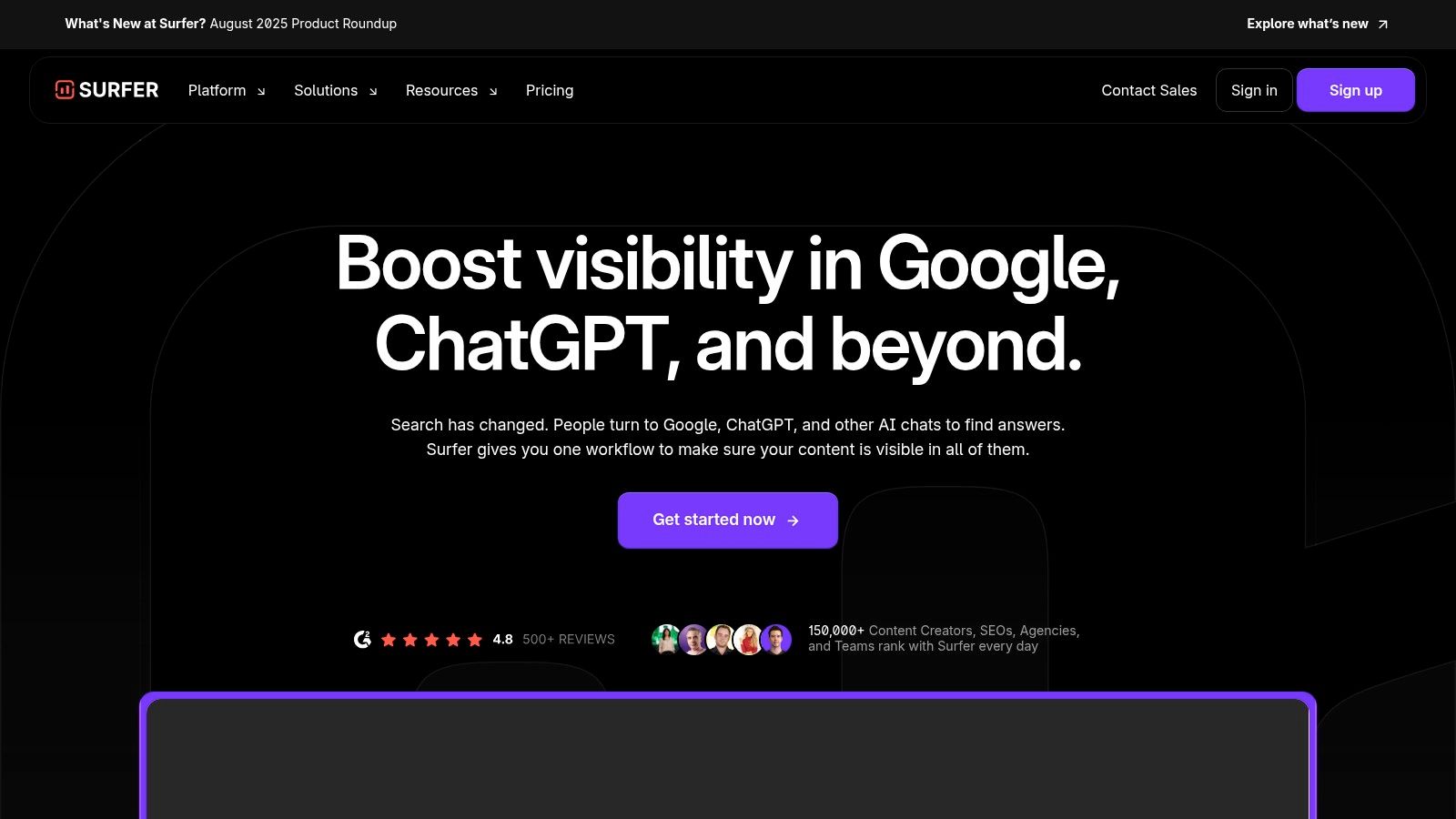
Key Agency Use Cases & Implementation
Surfer SEO is invaluable for scaling client content production without sacrificing quality. Agencies can use it to create detailed content briefs for freelance writers or in-house staff, ensuring consistency and SEO alignment across all client work. The SERP Analyzer and Keyword Research tools also help in identifying content gaps and opportunities for new client campaigns. While tools like Surfer SEO streamline the content optimization process, agencies should also be familiar with a broader range of comprehensive search engine optimization tips to maximize visibility.
- Pros: Excellent for improving client content visibility and search rankings with a data-backed approach. The user-friendly interface simplifies complex SEO analysis for your team.
- Cons: The tool can have a learning curve for team members completely new to on-page SEO principles, and it focuses primarily on content, not technical SEO audits.
Pricing is subscription-based, with different tiers based on the number of content editor queries and audits needed per month, making it scalable for agencies of all sizes.
Website: https://surferseo.com/
8. Hootsuite OwlyWriter AI: For Streamlining Social Media Management
For agencies managing multiple client social media accounts, Hootsuite’s OwlyWriter AI offers a major efficiency boost by embedding content creation directly into a familiar scheduling workflow. It acts as an integrated creative assistant, eliminating the need to switch between a separate AI writer and the Hootsuite dashboard. This makes it one of the most practical AI tools for marketing agencies focused on streamlining social media service delivery.
OwlyWriter can instantly generate captions for various platforms, repurpose high-performing client content into new formats, and even brainstorm fresh post ideas based on a simple prompt. This allows agency teams to accelerate content production while maintaining a consistent publishing schedule for clients.

Key Agency Use Cases & Implementation
OwlyWriter AI is built for agency-scale social media management. An agency can use it to quickly create a week's worth of social media copy for a new client campaign, instantly adapting the tone and style. Its content repurposing feature is particularly valuable, allowing you to turn a client's blog post URL into a series of engaging tweets or a LinkedIn post, maximizing the value of their existing assets.
- Pros: Seamless integration within the Hootsuite platform saves significant time for social media managers. The content idea generator helps overcome creative blocks for client accounts.
- Cons: The AI-generated content often requires manual refinement to perfectly match a specific client’s unique brand voice and tone.
OwlyWriter AI is available to users on all paid Hootsuite plans (Professional, Team, and Enterprise), with usage credits varying by tier, making it suitable for agencies with different client loads.
Website: https://hootsuite.com/
9. Lately.ai: For Automating Social Content Repurposing
For agencies struggling to keep client social media feeds consistently updated with fresh content, Lately.ai offers a specialized solution. It excels at taking a single piece of long-form client content, like a webinar, podcast, or blog post, and using AI to intelligently atomize it into dozens of high-quality social media posts. This unique content repurposing engine makes it one of the most effective AI tools for marketing agencies focused on maximizing client content ROI.
The platform analyzes your source content to identify key quotes and themes, then crafts posts that are contextually relevant and engaging. This drastically reduces the manual effort required to populate a client’s social media calendar, freeing up your agency team for higher-level strategy.

Key Agency Use Cases & Implementation
Lately.ai is ideal for turning a client's core content assets into a sustained social media campaign. An agency can upload a client's latest whitepaper and instantly generate a month's worth of social updates for LinkedIn, Twitter, and Facebook. The platform includes multichannel scheduling and performance analytics, allowing you to manage and report on these repurposed assets from a single dashboard.
- Pros: Dramatically increases content lifespan and reach by transforming one client asset into many. It simplifies multichannel social media management and content generation for your team.
- Cons: The initial setup and AI training can require a time investment to align the tool with a specific client’s brand voice and tone.
Lately.ai offers different pricing tiers based on the number of users and social accounts. For agencies managing multiple client portfolios, integrating this tool can streamline a core part of their service delivery, a key consideration for efficient agency project management.
Website: https://www.lately.ai/
10. AdCreative.ai: For Generating High-Converting Ad Creatives
For agencies that manage high-volume paid advertising campaigns for clients, AdCreative.ai provides a specialized solution to generate high-converting ad creatives at scale. The platform uses AI to produce hundreds of visual and text variations in minutes, dramatically reducing the time your team spends on design and copywriting. This focus on performance-driven creative makes it one of the most impactful AI tools for marketing agencies looking to optimize ad spend for clients.
The AI analyzes your client's brand assets and generates ready-to-launch creatives tailored for platforms like Facebook, Instagram, and Google. A key differentiator is its performance prediction engine, which scores each creative on its potential conversion rate, allowing teams to deploy only the most promising assets for a campaign.

Key Agency Use Cases & Implementation
AdCreative.ai is built for rapid A/B testing and campaign optimization for clients. Agencies can use it to quickly test different ad angles, messaging, and visuals to find the winning combination for each client audience. The direct integrations with major ad platforms like Meta and Google Ads streamline the process of pushing creatives live, saving valuable time. This allows account managers to focus more on strategy rather than the manual production of ad variants.
- Pros: Massively accelerates ad creative production for client campaigns. The performance prediction scores help de-risk ad spend by prioritizing high-potential creatives.
- Cons: The AI-generated designs can sometimes feel generic and may require manual tweaks to perfectly align with a specific client's unique brand identity.
Pricing is credit-based, with plans starting from a free trial to premium tiers offering more credits and features. Effective implementation involves creating distinct brand profiles for each client to ensure the AI has the right inputs.
Website: https://www.adcreative.ai/
11. Synthesia: For Scalable AI-Powered Video Production
Synthesia empowers agencies to move beyond traditional, costly video production by enabling the creation of professional-grade videos from simple text inputs. This platform uses realistic AI avatars and high-quality voiceovers to generate content, making it an essential tool for agencies looking to scale video marketing for clients without the logistical hurdles of filming. It is one of the most transformative AI tools for marketing agencies aiming to produce multilingual video content efficiently.
Agencies can rapidly produce client training videos, product explainers, and personalized sales outreach by simply typing a script. With support for over 120 languages and a variety of customizable video templates, creating localized campaigns for international clients becomes incredibly straightforward, saving immense time and budget.

Key Agency Use Cases & Implementation
Synthesia is a game-changer for producing client video content at scale. An agency can use it to create client onboarding materials, social media video ads, and internal training modules in a fraction of the time it would traditionally take. The ability to update videos by just editing the text script means client campaigns can be tweaked and redeployed quickly in response to performance data or market changes.
- Pros: Dramatically reduces the time and cost associated with video production for clients. The interface is intuitive, requiring no prior video editing skills, making it accessible to any team member.
- Cons: Creativity is limited by the available selection of stock AI avatars and voices. While custom avatars are possible for clients, they come at a significant additional cost.
Pricing is subscription-based, with plans tailored to individual or enterprise needs. The Personal plan is a good starting point, but agency-level features like collaboration and custom branding for clients are in the higher-tier plans.
Website: https://www.synthesia.io/
12. Anyword: For Performance-Focused Copywriting
Anyword goes beyond simple copy generation by adding a layer of predictive analytics, making it one of the most data-driven AI tools for marketing agencies. It specializes in creating and optimizing marketing copy that resonates with specific audiences by scoring its predicted performance. This allows agency teams to test and select the most effective ad copy, social media posts, or landing page headlines for clients before they even go live.
The platform's ability to learn a client's specific brand voice ensures all generated content remains consistent and on-brand. Agencies can create multiple brand voice profiles, making it easy to switch between clients and maintain distinct messaging for each one.

Key Agency Use Cases & Implementation
Anyword is ideal for agencies focused on performance marketing and conversion rate optimization (CRO) for their clients. Use it to generate multiple variations of ad copy for A/B testing on platforms like Facebook and Google, leveraging the predictive scores to prioritize the most promising options. The platform also streamlines the creation of high-converting website copy for clients, from CTAs to product descriptions.
- Pros: Enhances copy effectiveness for clients through predictive performance scores. The custom brand voice feature is excellent for managing multiple client accounts.
- Cons: The predictive scores are a guide, not a guarantee, and may still require manual adjustments for highly nuanced client brand messaging or niche audiences.
Anyword offers a free trial and paid plans starting from a Starter tier, with more advanced features and higher credit limits available in Business and Enterprise plans suitable for agency use.
Website: https://anyword.com/
Top 12 AI Marketing Tools Feature Comparison for Agencies
Final Thoughts
The landscape of marketing is shifting, and the agencies that thrive will be those that embrace intelligent automation and data-driven creativity. As we've explored, the market is no longer just experimenting with AI; it's actively integrating a diverse suite of powerful tools to gain a competitive edge. From drafting compelling ad copy with Jasper or Copy.ai to optimizing SEO strategies with Surfer SEO and automating complex workflows with Zapier, the potential to enhance every facet of your agency's operations is immense.
The key takeaway is that these platforms are not here to replace the strategic minds within your agency. Instead, think of them as powerful force multipliers. They handle the repetitive, data-intensive tasks that often consume valuable billable hours, freeing up your team to focus on what they do best: building client relationships, developing high-level strategy, and delivering truly creative, impactful campaigns. The adoption of the right AI tools for marketing agencies is no longer a luxury; it is a fundamental component of operational efficiency and strategic growth.
How to Choose the Right AI Stack for Your Agency
Navigating the crowded marketplace of AI solutions can be daunting. To build the most effective technology stack for your specific needs, avoid a one-size-fits-all approach and instead focus on a strategic, needs-based selection process.
- Start with a Pain Point Analysis: Before you even look at a demo, identify the biggest bottlenecks in your current workflow. Are you spending too much time on content ideation? Is social media management draining resources? Are client reporting and meeting documentation inefficient? Let your most significant challenges guide your search.
- Prioritize Integration Capabilities: An AI tool is only as good as its ability to work within your existing ecosystem. Look for solutions with robust API access or native integrations with your CRM (like HubSpot), project management software, and communication platforms. A disconnected tool creates more work, defeating the purpose of adoption.
- Balance Specialization and Versatility: Your stack should include both specialized tools (like AdCreative.ai for ad visuals or Synthesia for video) and versatile platforms (like Zapier for broad automation). This balance ensures you have a powerful, targeted solution for core tasks while maintaining flexibility for various client needs.
- Factor in the Learning Curve and Scalability: Consider your team's technical comfort level. Choose tools with intuitive interfaces and strong customer support to ensure smooth onboarding. Importantly, select platforms that can scale with your agency as you take on more clients and more complex projects.
Moving Forward: From Exploration to Implementation
The true value of this guide lies not in the reading but in the action that follows. Your next step is to move from passive learning to active implementation. Begin by selecting one or two tools from this list that address your most pressing operational pain point. Launch a pilot program with a small, dedicated team to test the tool's real-world impact on a specific client project.
By adopting a thoughtful and strategic approach, you can transform your agency from a service provider into an indispensable strategic partner, powered by the best AI tools for marketing agencies available today. The future is not about working harder; it's about working smarter, and AI is the key to unlocking that potential.
Ready to reclaim hours from your client meetings and internal debriefs? Scribbl uses AI to automatically transcribe, summarize, and generate follow-up items from your calls, ensuring no brilliant idea or critical client request gets lost. Try Scribbl today and see how effortless meeting intelligence can be.




